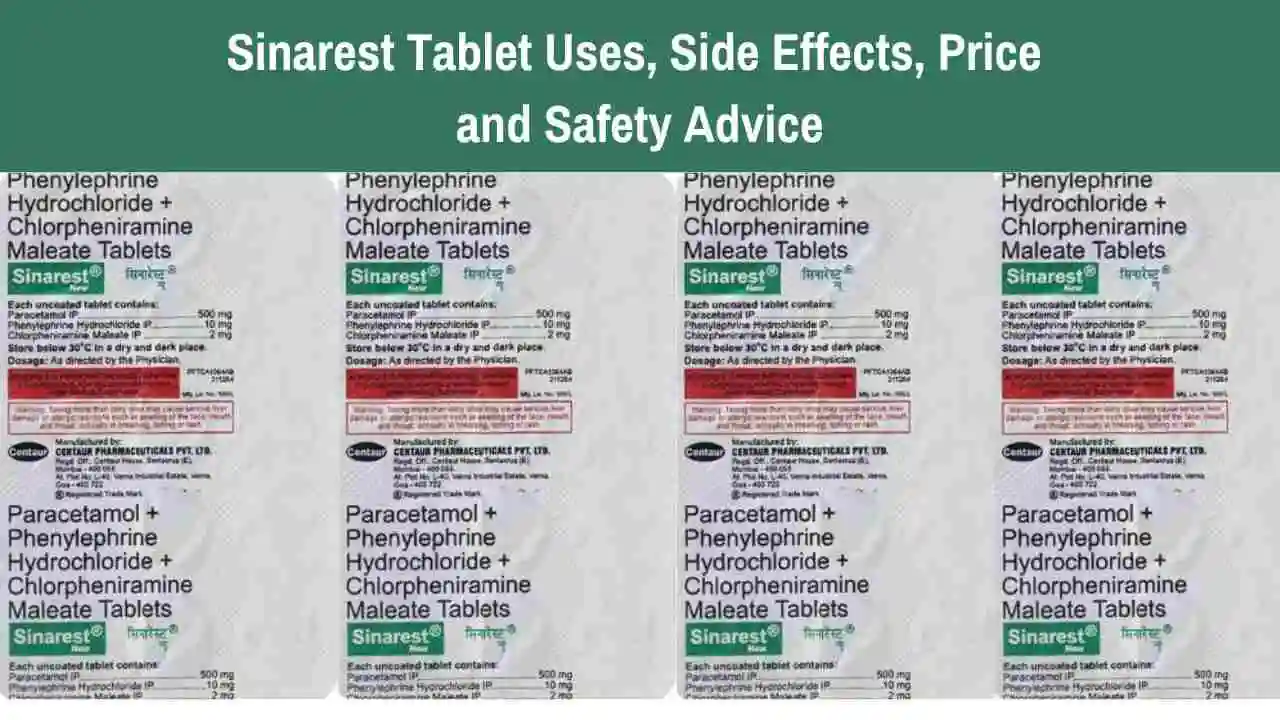Sinarest Tablet is used to treat various symptoms related to allergies, colds, and flu. This medicine contains a combination of active ingredients such as paracetamol, chlorpheniramine, and phenylephrine. These ingredients work together to alleviate symptoms such as fever, headache, body aches, nasal congestion, and sneezing.
In this article, we’ll take a closer look at the uses and benefits of Sinarest Tablet, its side effects, how to use it, how the drug works, safety advice, missed dose information, and all available substitutes.
| Price | ₹43.31 |
| Manufacture | Pfizer Ltd. |
| Ingredients | Chlorpheniramine Maleate (2mg), Paracetamol (500mg), and Phenylephrine Hydrochloride (5mg) |
| Uses | Nasal Congestion, Runny Nose, Sneezing, Cough, and Fever |
| Side Effects | Drowsiness, Dizziness, Dry Mouth, Nausea, Vomiting |
| Treatment | Antihistamine, Analgesic, and Decongestant |
| Storage | Store below 30°C in a cool and dry place, away from moisture and heat. Keep out of reach of children and pets. |
Sinarest Tablets Uses and Benefits:
Sinarest Tablet is primarily used to treat allergy, cold, and flu symptoms. It can help with fever reduction, headache relief, body aches, nasal congestion, and sneezing. This medication works by inhibiting the production of prostaglandins, which are responsible for the body’s fever, pain, and inflammation. Furthermore, the drug contains chlorpheniramine, which helps to reduce allergic reactions, and phenylephrine, which helps to shrink blood vessels in the nasal passages, reducing congestion.
Common Side Effects of Sinarest Tablet
Drowsiness
Dry Mouth
Blurred Vision
Dizziness
Constipation
If you experience any of these side effects, you should consult a doctor. In rare cases, Sinarest Tablet may cause more severe side effects such as difficulty breathing, chest pain, seizures, and irregular heartbeat. Seek medical attention right away if you notice any of these symptoms
How to Use Sinarest Tablet?
Sinarest Tablet should be taken with a glass of water orally. The dosage is determined by the severity of your symptoms as well as your age. It is critical to follow your doctor’s instructions regarding dosage and treatment duration. Do not exceed the recommended dosage because doing so can result in serious side effects.
How the Sinarest Tablet Works?
Sinarest Tablet contains a combination of active ingredients that work together to relieve allergy, cold, and flu symptoms. Chlorpheniramine reduces allergic reactions while paracetamol reduces fever and pain. Phenylephrine constricts blood vessels in the nasal passages, which relieves congestion.
Safety Advice
Before taking Sinarest Tablet, it’s important to inform your doctor if you have any pre-existing medical conditions or are taking any other medications. This medication may not be suitable for individuals with certain medical conditions, such as liver or kidney disease. Additionally, this medication may interact with certain other medications, so it’s important to inform your doctor of all medications you are taking.
Here are the Safety Advice Tips for Sinarest Tablet
- Alcohol: It is advisable to avoid or limit the consumption of alcohol while taking Sinarest Tablet as it may increase the risk of side effects such as drowsiness, dizziness, and impaired coordination.
- Pregnancy: Sinarest Tablet should only be used during pregnancy if it is absolutely necessary and under the guidance of a doctor. It may not be safe to use Sinarest Tablet during pregnancy as it may harm the developing fetus.
- Breastfeeding: Sinarest Tablet should not be used while breastfeeding as it may pass into breast milk and harm the nursing infant. Consult your doctor before using Sinarest Tablet if you are breastfeeding.
- Driving: Sinarest Tablet may cause drowsiness, dizziness, and impaired coordination, which may affect your ability to drive or operate heavy machinery. It is advisable to avoid driving or operating machinery while taking Sinarest Tablet.
- Kidney: Sinarest Tablet should be used with caution in patients with kidney disease as it may worsen the condition. Consult your doctor before using Sinarest Tablet if you have kidney disease.
- Liver: Sinarest Tablet should be used with caution in patients with liver disease as it may worsen the condition. Consult your doctor before using Sinarest Tablet if you have liver disease.
Missed Dose
Sinarest Tablet should be taken as soon as you remember if you miss a dose. If your next dose is almost due, skip the missed one and carry on with your regular dosing schedule. To make up for a missed dose, do not take a second one.
Substitutes
Sinarest Tablet can be replaced with a number of medications, including Cetzine, Dolo Cold, Maxtra, and Sudafed. Before switching to a different medication, it’s crucial to speak with your doctor. Based on your symptoms and medical history, they can recommend the best replacement.
Drug Interaction of Sinarest Tablet
Sinarest Tablet can interact with several other medications, so it’s important to inform your doctor of all medications you are taking before starting Sinarest Tablet. Here are some of the medications that may interact with Sinarest Tablet:
Monoamine oxidase inhibitors (MAOIs): MAOIs are a type of medication used to treat depression. Taking Sinarest Tablet with MAOIs can increase the risk of high blood pressure, seizures, and other serious side effects.
Beta-blockers: Beta-blockers are a type of medication used to treat high blood pressure and heart conditions. Taking Sinarest Tablet with beta-blockers can increase the risk of high blood pressure and other cardiovascular side effects.
Anticoagulants: Anticoagulants, also known as blood thinners, are medications used to prevent blood clots. Taking Sinarest Tablet with anticoagulants can increase the risk of bleeding and other blood clotting disorders.
Antidepressants: Antidepressants are medications used to treat depression and other mental health conditions. Taking Sinarest Tablet with antidepressants can increase the risk of serotonin syndrome, a potentially life-threatening condition.
Other cold and allergy medications: Taking Sinarest Tablet with other cold and allergy medications can increase the risk of side effects such as drowsiness, dizziness, and blurred vision
In conclusion, Sinarest Tablet is a medication that is commonly used to alleviate symptoms of allergies, colds, and flu. It contains a combination of active ingredients that work together to reduce fever, relieve pain, reduce allergic reactions, and alleviate nasal congestion. Like any medication, it may cause side effects, and it’s important to follow your doctor’s instructions regarding dosage and duration of treatment. If you experience any severe side effects, seek medical attention immediately. Finally, if you’re considering switching to a different medication, consult your Doctor.
You May Also Like
Frequently Asked Questions on Sinarest Tablet
Sinarest Tablet is used to treat cold, flu, and allergy symptoms like runny nose, nasal congestion, sneezing, coughing, and fever.
Sinarest Tablet is made up of a number of active ingredients that work together to reduce inflammation, constrict blood vessels, and prevent the production of histamine, a substance that causes allergy symptoms.
Sinarest Tablet should be used during pregnancy only when absolutely necessary and under the supervision of a doctor. It may not be safe to use Sinarest Tablet during pregnancy as it may harm the developing foetus.
Sinarest Tablet should not be taken while breastfeeding because it can enter breast milk and harm the nursing infant. Consult your doctor before using Sinarest Tablet if you are breastfeeding
Sinarest Tablet should only be administered to children under the supervision of a doctor. Sinarest Tablet dosage and safety may differ depending on the child’s age and weight.
Sinarest Tablet should be taken exactly as prescribed by a doctor or as directed on the label. It is typically taken with or without food and a full glass of water.
Sinarest Tablet should be taken as soon as you remember if you miss a dose. Skip the missed dose and take the subsequent dose at the scheduled time if it is almost time for your next dose.
The common side effects of Sinarest Tablet include drowsiness, dizziness, dry mouth, nausea, and vomiting. If any of these side effects persist or worsen, contact a doctor.
Yes, drowsiness is a common side effect of Sinarest Tablet. While taking Sinarest Tablet, it is best to avoid driving or operating machinery.
Sinarest Tablet may interact with a number of other medications, so inform your doctor about all medications you are taking before beginning Sinarest Tablet.
It is best to avoid or limit your alcohol consumption while taking Sinarest Tablet. In addition, if you have kidney or liver disease, consult your doctor before using Sinarest Tablet.
Sinarest Tablet’s onset of action varies depending on the individual and the severity of the symptoms. Consult your doctor about the duration of treatment.
Sinarest Tablet should not be used for an extended period of time without the supervision of a doctor. Sinarest Tablet use for an extended period of time may result in dependence, tolerance, and other serious side effects.
Seek immediate medical attention if you overdose on Sinarest Tablet. Overdoes can cause confusion, hallucinations, seizures, and respiratory depression.
Sinarest Tablet should be kept at room temperature and out of the reach of children. Keep it away from children and pets.


